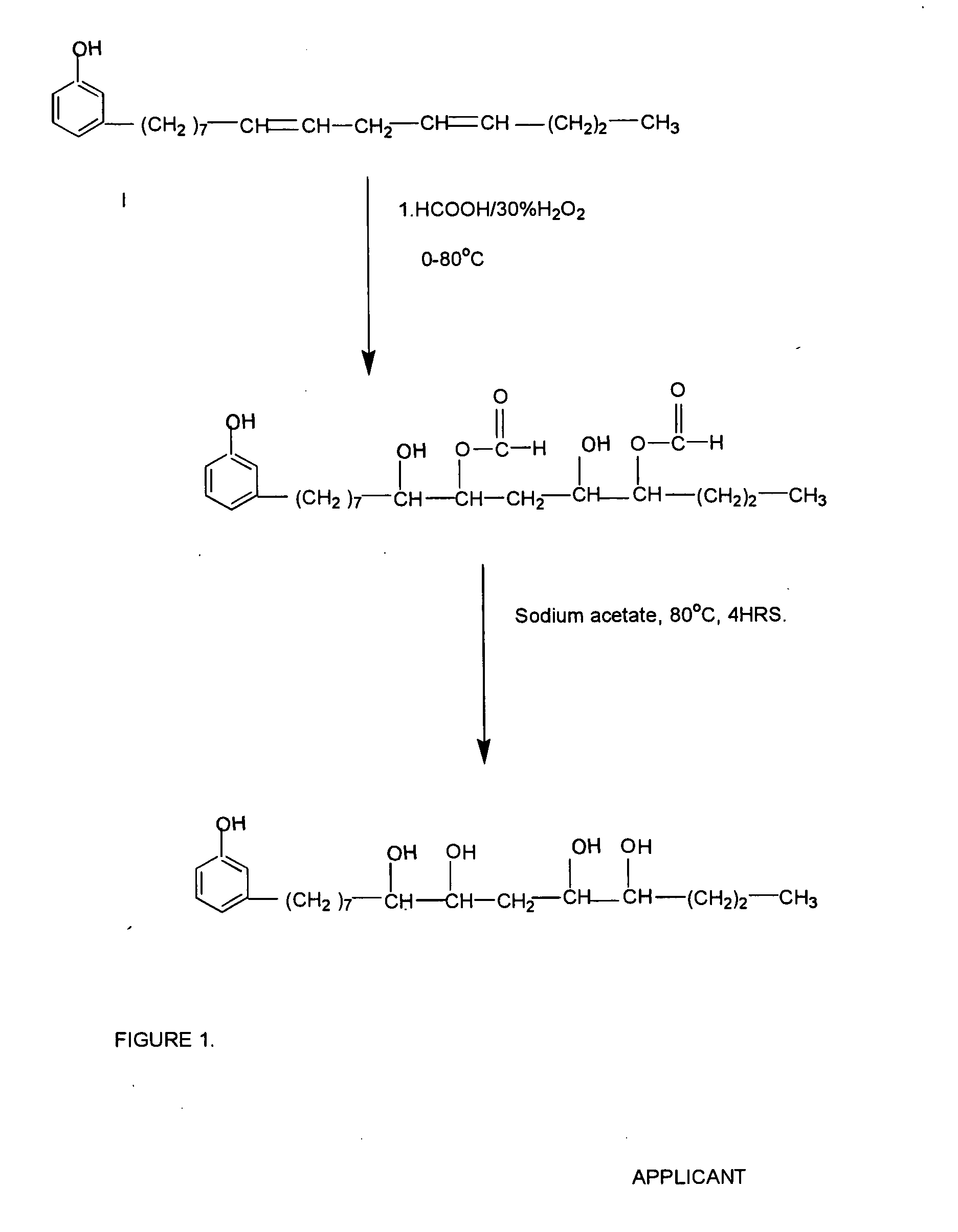Process for preparing polyurethane polyol and rigid foams therefrom from cardanol
- Summary
- Abstract
- Description
- Claims
- Application Information
AI Technical Summary
Benefits of technology
Problems solved by technology
Method used
Image
Examples
example 1
[0031] A mixture of 7.82 g of formic acid [0.17 mole] and 50 g of cardanol [0.17 mole] is taken together in a glass vessel and the mixture under stirring is cooled to 0° C. While stirring continued and maintaining the temperature, 38.5 g (0.34 mole) of 30% H2O2 is added drop wise from a pressure equalizing funnel. The addition time required 5-10 hours. During addition the temperature is maintained by a cooling bath.
[0032] After completion of the addition, the reaction temperature is increased to 35° C., whereby the epoxy groups present is converted to hydroxyl-formoxy ester. The half ester so produced is hydrolyzed with sodium acetate at 80° C. for 4 hours. The product is neutralized, washed with excess water till neutral to litmus and dried over anhydrous sodium sulphate.
example 2
[0033] A mixture of 20 g of formic acid [0.57 mole] and 151 g of cardanol [0.5 mole] is taken together in a glass vessel and the mixture under stirring is cooled to 0° C. while stirring continued and maintaining temperature 116 g 30% (1.02 mole) H2O2 is added drop wise from a pressure equalizing funnel. The addition is completed in 5-10 hours. During addition the temperature is maintained by a cooling bath.
[0034] After the complete addition, the reaction temperature is increased to 35° C., whereby the epoxy groups present is hydrolyzed to hydroxyl-formoxy ester. The half ester so produced is hydrolyzed with sodium acetate at 80° C. for 4 hours. The product is neutralized, washed with excess water till neutral to litmus and dried over anhydrous sodium sulphate.
example 3
[0035] In another example a mixture of 19 g of formic acid [0.6 mole] and 150 g of cardanol [0.5 mole] is taken together in a glass vessel and the mixture stirred at cooled to 0° C. while stirring continued and maintaining temperature 115 g 30% (1.02 mole) H2O2 is added drop wise from a pressure equalizing funnel. The addition is required 5-10 hours. During addition the temperature is maintained by ice cooling at 24-32° C.
[0036] After complete addition, the reaction temperature is increased to 35° C., whereby the epoxy groups present is hydrolyzed to hydroxyl-formoxy ester. The half ester so produced is hydrolyzed with sodium acetate at 80° C. for 4 hours. The product is neutralized, washed with excess water till neutral to litmus and dried over anhydrous sodium sulphate.
[0037] The mineral acid catalyst such as conc H2SO4 is used in an amount 0.05% to 5% on the weight of cardanol. At the end of the reaction the product is taken in a separating funnel washed with excess of water ti...
PUM
| Property | Measurement | Unit |
|---|---|---|
| Temperature | aaaaa | aaaaa |
| Temperature | aaaaa | aaaaa |
| Fraction | aaaaa | aaaaa |
Abstract
Description
Claims
Application Information
 Login to View More
Login to View More - R&D
- Intellectual Property
- Life Sciences
- Materials
- Tech Scout
- Unparalleled Data Quality
- Higher Quality Content
- 60% Fewer Hallucinations
Browse by: Latest US Patents, China's latest patents, Technical Efficacy Thesaurus, Application Domain, Technology Topic, Popular Technical Reports.
© 2025 PatSnap. All rights reserved.Legal|Privacy policy|Modern Slavery Act Transparency Statement|Sitemap|About US| Contact US: help@patsnap.com

